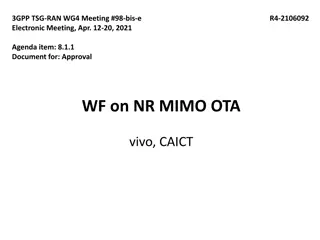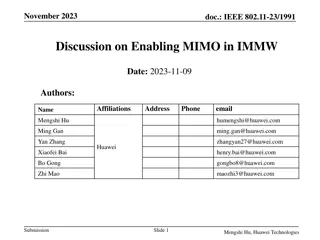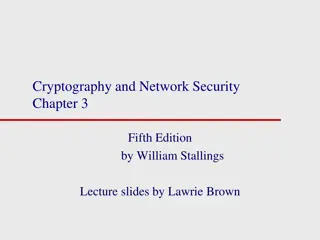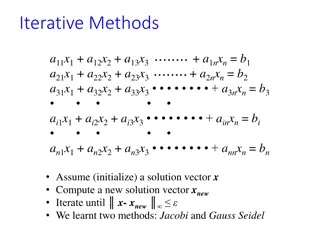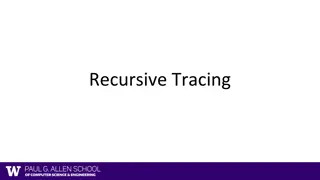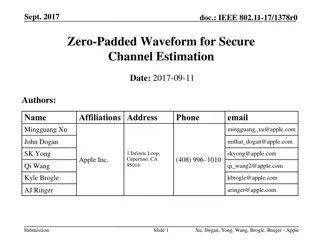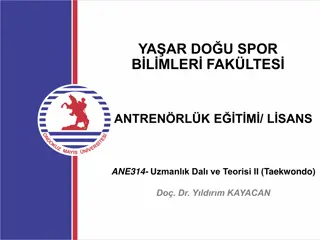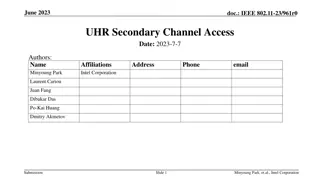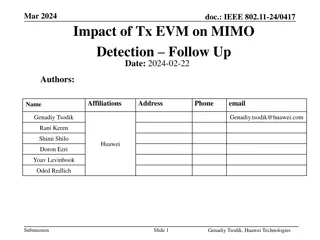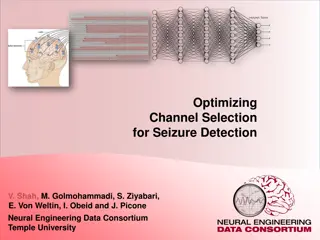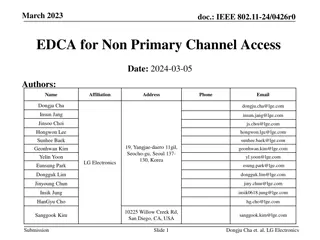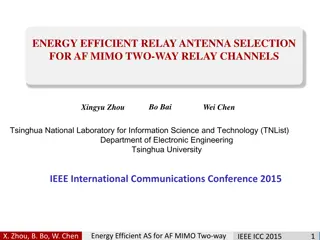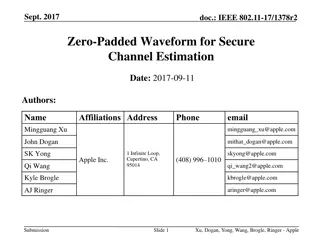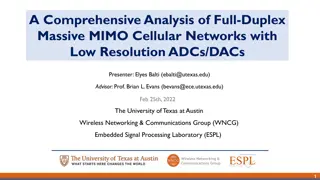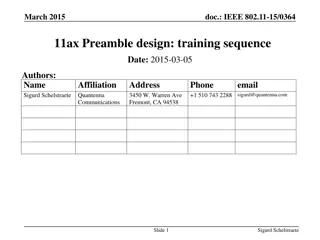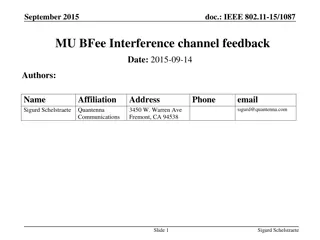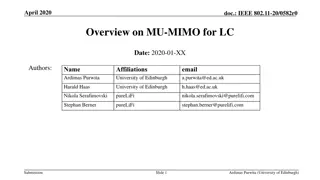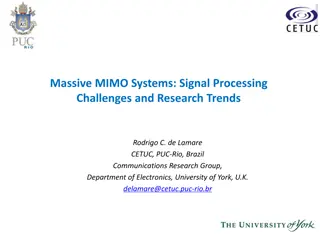
Innovative Approach to Massive MIMO Channel Estimation
"Explore a cutting-edge method for channel estimation in Massive MIMO systems based on block iterative support detection. This research, conducted by a team from Tsinghua University and Huawei Technologies, sheds light on enhancing 5G performance through advanced signal processing techniques."
Download Presentation

Please find below an Image/Link to download the presentation.
The content on the website is provided AS IS for your information and personal use only. It may not be sold, licensed, or shared on other websites without obtaining consent from the author. If you encounter any issues during the download, it is possible that the publisher has removed the file from their server.
You are allowed to download the files provided on this website for personal or commercial use, subject to the condition that they are used lawfully. All files are the property of their respective owners.
The content on the website is provided AS IS for your information and personal use only. It may not be sold, licensed, or shared on other websites without obtaining consent from the author.
E N D
Presentation Transcript
Massive MIMO Channel Estimation Based on Block Iterative Support Detection Wenqian Shen1, Linglong Dai1, Yi Shi2, Zhen Gao1, and Zhaocheng Wang1 1Tsinghua University, Beijing, China 2Huawei Technologies, Beijing, China
Contents 1 Technical Background 2 Proposed Solution 3 Performance Analysis 4 Simulation Results 5 Conclusions Massive MIMO Channel Estimation Based on Block Iterative Support Detection 2/21
Key Performance Indicator (KPI) of 5G ITU Sep. 2015 Massive MIMO Channel Estimation Based on Block Iterative Support Detection 3/21
How to Realize 5G? One consensus ten years Improve the system capacity 1000x in Massive MIMO Massive MIMO Channel Estimation Based on Block Iterative Support Detection 4/21
What is Massive MIMO? Use hundreds of base station (BS) antennas to simultaneously serve multiple users Conventional MIMO ??:2~8, K:1~4 (LTE-A) Massive MIMO ??: ~100~1000, K: 16~64 [1] T. L. Marzetta, Non-cooperative Cellular Wireless with Unlimited Numbers of Base Station Antennas, IEEE Transactions on Wireless Communications, vol. 9, no. 11, pp. 3590-3599, Nov. 2010. (2013 IEEE Marconi prize) Massive MIMO Channel Estimation Based on Block Iterative Support Detection 5/21
Overwhelming Pilot Overhead Channel state information (CSI) is essential for precoding and power allocation Orthogonal pilots for LTE/LTE-A Tx = 16 100% pilot ! Tx = 64 R14 R59 R60 R13 R63 R56 R57 R58 R61 R14 R15 R62 K=7 K=7 R12 R50 R12 R54 R12 R13 R52 R48 R49 R51 R53 R55 R10 R41 R44 R11 R45 R10 R11 R40 R42 R43 R46 R47 Data Data R8 R8 R32 R9 R36 R33 R34 R2 R35 R3 R37 R38 R9 R39 R28 R24 R25 R26 R27 R29 R6 R7 R30 R31 R20 R16 R17 R2 R18 R19 R21 R2 R4 R3 R5 R3 R22 R23 R12 R2 R3 R8 R9 R10 R11 R13 R14 R15 K=0 R0 R1 R7 R3 R4 R5 R6 R8 K=0 R0 R2 L=0 L=7 L=0 L=7 Time (symbol) Time (symbol) The number of orthogonal pilots is linearly increased with the number of BS antennas Massive MIMO Channel Estimation Based on Block Iterative Support Detection 6/21
CS-Based Channel Estimation Compressive Sensing (CS) Reconstruct a sparse signal by a sampling rate much lower than the Nyquist rate 3GPP 6-path Vehicular A channel [3GPP TR 25.996] Sparsity in channel impulse response (CIR) The number of significant paths in CIR is limited Conventional CS-based channel estimation schemes usually assume prior knowledge of channel sparsity level Massive MIMO Channel Estimation Based on Block Iterative Support Detection 7/21
Contents 1 Technical Background 2 Proposed Solution 3 Performance Analysis 4 Simulation Results 5 Conclusions Massive MIMO Channel Estimation Based on Block Iterative Support Detection 8/21
System Model Rewrite as Matrix N T = + y Ph n = + y C F h n ( ) i L i = 1 i y = C c diag{ } i i L F ( ) ih n = T T T T = h h h h [ , , , ] P C F C F C F [ ( ) , ( ) , , ( ) ] 1 2 1 2 L L N L N T T Massive MIMO Channel Estimation Based on Block Iterative Support Detection 9/21
Block Sparsity CIRs share a common support since different CIRs associated with different antennas have similar path arrival times + = L l + P (:,( 1) ) (:,( 1) ) l N n n t t t = + y Ph n = + y g n + = L l + g h (( 1) ) (( 1) ) l N n n T t t Massive MIMO Channel Estimation Based on Block Iterative Support Detection 10/21
Block Iterative Support Detection Our proposed Block- ISD algorithm Support detection is based on sparsity level-independent threshold, which is dependent on the `first significant jump' rule [2] Only if more than half of the elements in a block are non- zero elements, this block will updated as non-zero block [2] Y. Wang and W. Yin, ``Sparse signal reconstruction via iterative support detection," SIAM Journal on Imaging Sciences, vol. 49, no. 6, pp. 2543-2563, Jun. 2011. Massive MIMO Channel Estimation Based on Block Iterative Support Detection 11/21
Contents 1 Technical Background 2 Proposed Solution 3 Performance Analysis 4 Simulation Results 5 Conclusions Massive MIMO Channel Estimation Based on Block Iterative Support Detection 12/21
Maximal Mutual Coherence (MMC) MMC is defined as the largest normalized absolute inner product between any two columns, i.e., p p p | , | i j = ( ) P max . i j LN 1 p T 2 2 i j P The smaller MMC of the sensing matrix P ensures reliable channel estimation performance [3] h K h h 2 ( )(4 P 1 1) K is the recovered channel vector is the noise power is the sparsity level of channel vector [3] M. Duarte and Y. Eldar, ``Structured compressed sensing: From theory to applications," IEEE Trans. Signal Process., vol. 59, no. 9, pp. 4053-4085, Sep. 2011. Massive MIMO Channel Estimation Based on Block Iterative Support Detection 13/21
Maximal Mutual Coherence (MMC) The MMC is dependent on the pilot sequence since p LN = P C F C F C F [ ( ) , ( ) , , ( ) ] C T 1 2 L L N L T Unit-norm pilot pattern The elements of the pilot sequences Ci have independent random phases but a unit amplitude Then, the MMC is expressed as 1 ( ) max i j n p ic 2 N p ( ) j m n n k = 1 2 k * i k P , c c e or , , n j k 1 2 = 1 where denotes the k-th element of is the set of subcarrier indexes assigned to pilots 1 { }p k k m = 1 , , 0 , 1 i j N n n L 1 2 T , i k c ic Massive MIMO Channel Estimation Based on Block Iterative Support Detection 14/21
Expectation of MMC = n n (a) if and i j 2 N p 1 p ( ) j m n n 1 2 = 1 2 k ( ) P max e m N = 1 k [0,1) U k The expectation of is zero since ( ) P p p = n n 1 p 1 p (b) if and i j 2 ( ) j = = * i k ( ) P max max c c e 1 2 , , j k i k , , j k = = 1 1 k k The expectation of is zero since P ( ) [0,1) U , , i k j k n n (c) if and i j 1 2 m N p 1 p k 2 ( ) ( + ( )) j n n = 2 1 , , j k i k ( ) P max e i j and n n 1 2 = 1 k m N The expectation of is zero since ( ) P [0,1) U k , , i k j k Massive MIMO Channel Estimation Based on Block Iterative Support Detection 15/21
Contents 1 Technical Background 2 Proposed Solution 3 Performance Analysis 4 Simulation Results 5 Conclusions Massive MIMO Channel Estimation Based on Block Iterative Support Detection 16/21
Simulation Results Parameters ITU Vehicular B channel model number of antennas N = 1 10 BP [17] ISD [13] Proposed Block-ISD Exact LS 32 0 10 T system bandwidth 50 MHz NMSE -1 10 OFDM symbol length N = 4096 -2 10 maximal channel length 128 L = -3 10 5 10 15 20 25 30 SNR (dB) number of pilots p = 640 Massive MIMO Channel Estimation Based on Block Iterative Support Detection 17/21
Simulation Results (580 510)/580 12% = Pilot Overhead Reduction: 1 0.9 BP [17] ISD [13] Proposed Block-ISD 0.8 Channel reconstruction frequency 0.7 0.6 0.5 0.4 0.3 0.2 0.1 0 300 400 500 600 700 800 900 Number of pilots (p) Massive MIMO Channel Estimation Based on Block Iterative Support Detection 18/21
Contents 1 Technical Background 2 Proposed Solution 3 Performance Analysis 4 Simulation Results 5 Conclusions Massive MIMO Channel Estimation Based on Block Iterative Support Detection 19/21
Conclusions With greatly increased number of BS atnennas in massive MIMO systems, the pilot overhead for accurate acquisition of CSI will be prohibitively high We propose the block-ISD algorithm, which fully exploits the block sparsity inherent in the block-sparse equivalent CIR Furthermore, block-ISD requires no prior knowledge of the channel sparsity level and is thus more practically appealing Simulation results have demonstrated that block-ISD can achieve a reduction of 12% pilot overhead than ISD Massive MIMO Channel Estimation Based on Block Iterative Support Detection 20/21
Thanks for you attention ! swq13@mails.tsinghua.edu.cn Massive MIMO Channel Estimation Based on Block Iterative Support Detection 21/21



